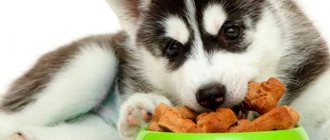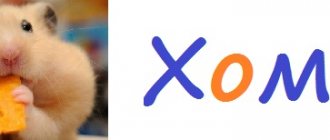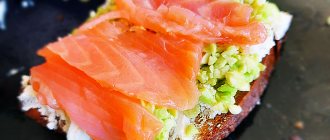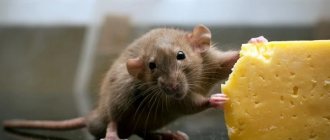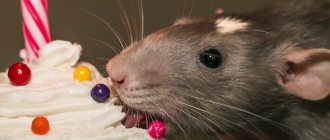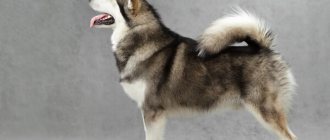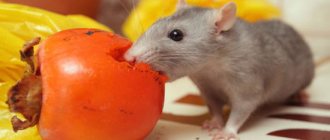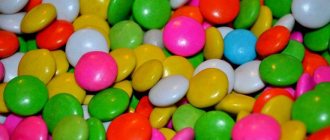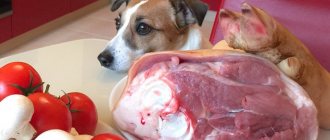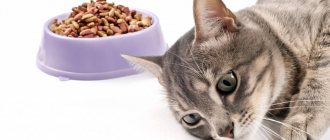If you are preparing to buy a husky puppy, you are probably wondering: what to feed him? The problem is that it is very difficult for novice owners to make a decision, because there are hundreds of manufacturers of ready-made food on the market. You also need to choose food on which your dog’s healthy functioning will depend. In this article you will learn about all the intricacies of feeding a husky, find out when and how to do it correctly and, ultimately, get rid of this problem.
This wonderful breed, bred from aboriginal dogs, was intended for riding, so its distinctive features are speed, great performance, strength and endurance. However, due to their loyalty and friendliness, today they like to keep huskies in apartments, as a pet and companion. And since these dogs differ in many ways from other breeds, special attention must be paid to their feeding.
Nutrition
Nutrition plays a big role in the growth and development of a puppy . In childhood, the formation of the musculoskeletal system and the formation of muscles occurs, and specialized feeding affects:
- dental condition;
- gums;
- joints;
- improved digestion;
- maintaining immunity;
- work of the central nervous system.
Food must be nutritious and contain all the necessary vitamins, minerals, micro and macroelements.
Before you start feeding the animal, you must decide on the method of feeding it. There are 2 types:
- natural;
- ready-made (purchased) food.
Natural food or artificial food?
The owner of a husky puppy must decide what he will feed the pet: natural products or ready-made factory-made food. You cannot combine two types of food.
During heat treatment, partial breakdown of nutritional components occurs, that is, the initial stage of digestion has already occurred. And natural products need to be digested from scratch. This feed mixture disrupts the work of enzymes, causing digestive upset.
Natural diet
Every person wants to see their dog healthy, active and cheerful, and these factors largely depend on proper nutrition. Consequently, most people are confident in the absolute usefulness of natural food, because they can track what exactly goes into their dog’s body, but they do not trust store-bought food. However, this approach is erroneous, since this diet may not always be balanced.
You should know that the metabolism of the Siberian husky, like that of wolves, is protein-fat, and not protein-carbohydrate.
The advantages of natural food include:
- has no harmful additives;
- contains a sufficient amount of fiber and protein;
- the choice and quality of products are intended for the owner.
Minuses:
- takes a significant amount of time;
- difficulties with switching to another food;
- unbalanced diet.
To ensure a balanced diet, follow the percentage ratio.
General rules
- 50 – 70% of all food is meat.
- 10 – 20% of all food is cereals.
- 20 - 30% of all food is vegetables.
- 10–20% of all food is dairy products.
Main Products
- Meat . Low-fat varieties are best - chicken, turkey, beef, venison. But pork and lamb should be avoided. Boiled meat with cartilage and films will bring great benefits to the dog’s body.
- Offal . Sometimes they can be an excellent substitute for meat, or add variety to the protein diet. These are the scar, liver, heart, lung, trachea, spleen and kidneys.
- Fish . Red sea fish (trout, char, salmon, etc.) are suitable as an additional source of protein and essential amino acids. The benefits of fish cannot be overestimated, because its protein is easily digestible, and the product itself contains a large amount of vitamins (A, B1, B2, B3, B6, B9, B12, C, D, E) and minerals (potassium, phosphorus, sulfur, chlorine, sodium, magnesium, calcium, iodine, zinc, iron, fluorine). Thanks to this composition, the dog’s thyroid function is normalized, metabolic processes, memory and attention are improved, which is important when training and teaching commands. Essential amino acids contained in it, such as arginine, tryptophan, methionine, leucine, valine, lysine, threonine, have an antioxidant effect, and the presence of hyaluronic acid and collagen is excellent for the health of the pet’s ligaments and cartilage.
- Eggs . It is allowed to give both quail (2 - 3 pieces) and chicken (boiled or raw).
- Vegetables, boiled, or with the addition of vegetable oil . Necessary micro and macroelements are found in zucchini, pumpkin, cabbage, cucumbers, carrots and beans.
- Fruits . Many pets cannot live without fruit. Pamper them with small portions of banana, apple, pear and tangerine slices.
- Fermented milk products . The basis for the musculoskeletal system is low-fat fermented milk products - cottage cheese, kefir. However, they must be absolutely fresh.
- Cereals . To prepare porridge, you need to use only three types of cereals: oatmeal, rice and buckwheat. They contain fiber and dietary fiber, which affect the smooth functioning of the intestines.
“Remember, obesity is a dangerous disease that has critical consequences. Periodically feel your dog’s ribs and monitor his weight.”
Nutritional supplements
After consulting with your veterinarian in advance, you can add the following supplements::
- Brewer's yeast;
- bone flour;
- fish fat;
- calcium tablets.
Breed standard
The Siberian Husky is a medium-sized working dog. For hundreds of years it was used as a riding vehicle. Today this breed is very popular, and this is not surprising. Despite her powerful appearance, she is kind to children, affectionate, and very faithful to her owner.
An adult dog has a muscular body and strong bones. Males are seasoned and hardy, but are not distinguished by rudeness, females are graceful, although they have developed muscles.
What are the breed standards?
In dogs that are black, red and gray in color, the nose is black, in dogs of a copper shade it is chestnut, in snow-white dogs it is flesh-colored. The muzzle is average in length and width, becoming narrower closer to the ears. The lips are pigmented and fit tightly. The slightly slanted eyes of the husky are mesmerizing. Eye colors are brown and blue. The look of a dog of this breed is piercing, but friendly and not without a hint of mischief. The ears are medium in size, stand vertically upward, are close to each other, and have a triangular shape.
During the stance, the husky holds his head proudly raised. The beautiful curved neck gives the dog a proud posture. The back is straight. The tail is of the “fox” type, equally pubescent on all sides. When the dog is tense, the tail is raised and resembles a sickle. The coat is “double” of medium length. The coat is dense, but not long. When the dog moves, the tail does not curl to the side. Colors are allowed from black to snow-white. There may be markings and various patterns on the head.
Similar article: History of origin and description of the Shar Pei breed
So, the main characteristics of the breed:
- the average size;
- proportionate strong body;
- correct tail;
- dense and coarse coat;
- friendly character;
- high degree of endurance.
Ready food
Store-bought food consists of canned food and dry granules.
Advantages of ready-made food:
- quick cooking;
- contains all the necessary substances;
- ease of use and transportation;
- developed menu.
Disadvantages include::
- lack of moisture;
- difficulties in selection;
- expensive;
- presence of preservatives;
- inability to provide natural products.
Attention! It is strictly forbidden to mix natural food with prepared food! These are too different types of food.
Recipes for pets
Meat porridge (for two servings). Half a kilogram of beef is mixed with 300 grams of porridge and filled with water. After boiling, add carrots, chopped cabbage or zucchini and salt. It is also allowed to use bay leaf.
Chicken porridge (for 4 servings). A kilogram of chicken legs is filled with water and cooked for 30 minutes, 100 grams of rice, carrots, and bay leaves are added. Cook until the rice is ready.
Oatmeal. The flakes are not boiled, but poured with hot water or meat broth, covered with a lid and left to infuse for up to half an hour. Then butter and salt are added to the porridge.
Cottage cheese. Curd starter is sold at any pharmacy. To prepare, you need to take a yogurt maker or a multicooker. A packet of starter is added to a liter of pasteurized milk. Next you need to follow the instructions. If you can’t buy a yogurt maker yet, you can add the starter to the pan and put it in a warm place for the specified time.
Cottage cheese, kefir or fermented baked milk is served to your pet at room temperature. This is an excellent breakfast that will help strengthen bones and prevent the development of rickets.
There are no special requirements for the bowl from which the dog will eat. The main thing is cleanliness, it must be washed after every meal and make sure that the Husky always has fresh, clean, filtered water. True, to prevent it from breaking the dishes, it is better to avoid porcelain and glass items. Plastic or metal bowls are optimal.
Currently reading:
- Interesting facts about the Alaskan Klee Kai breed
- Games to choose for training a dog
- How to create the right diet for Shar Pei
- Is it worth it or not to include natural food in your dog’s diet?
Can I feed dry food?
As mentioned above, the choice of food is yours, but it also depends on the dog. Watch your husky and see what he likes to eat more - dry food or home-made natural products. There are individuals with individual intolerance to one of the feeding methods . Some cannot eat ready-made food - they immediately begin to have digestive problems and diarrhea, while others, on the contrary, have a similar reaction to natural food.
Make sure there is fresh water in the bowl! Especially when feeding dry food, the dog should always have enough drinking water.
Pet stores will provide you with a wide range of dry food manufacturers. In this case, the price directly depends on the quality.
Buy premium and super-premium food:
- Particularly inexpensive of them, and corresponding to average good quality, are Pro Plan, Royal Canin.
- Higher level – Eukanuba, Hills, Acana, Orijen.
At what age is it better to start and what is the best age?
Let's figure out what to feed puppies 1 month or older. In any food, regardless of the brand, there are age ranges :
- For puppies from 3 weeks to 2 months and pregnant bitches – STARTER.
- For puppies from 2 to 10 months – PUPPY.
- For dogs from 8 months to 2 years – JUNIOR.
- For dogs from 1 to 6 years old – ADULT.
- For dogs over 6 years old - food with the wording “for older dogs”.
When do puppies start walking?
First, the dogs' eyes and ear canals open, then they stand on their paws and begin to move unsteadily. This occurs on days 14-18 of the puppies' life. The fewer cubs in the litter, the stronger they are usually, and the faster their motor function develops. At the age of three weeks, the babies begin to leave the nest, exploring the space. They play with each other. It is necessary to provide young people with safe space to move around.
In order for the musculoskeletal system of puppies to develop healthy, they must receive a sufficient amount of mother's milk. Accordingly, a nursing bitch should eat well and get calcium from her diet. At one month of age, puppies can already lap on their own. But it’s too early to separate them from their mother at this time. After all, it is by being next to her that dogs socialize, that is, they acquire skills to behave in the environment. They copy the behavior of the bitch. The period of socialization, which takes place between 4 and 16 weeks of a puppy’s life, forms the basis for the dog’s further behavioral reactions. From the age of one month, dogs learn to regulate the force of their bite, they learn to adequately perceive people and identify their owner. Adapting to the outside world together with their mother, the puppies feel protected and confident. They boldly explore ever larger territories and then return to their mother. And early separation from her often makes dogs fearful, because socialization has not been completed completely. Such dogs grow up timid, can shy away from sharp sounds and hide in secluded places. They do not make guard dogs.
The minimum age for a puppy to be separated from its mother is 8 weeks, but it is better to do this at 12. By this period, she ceases to synthesize pheromones that connect with the offspring. Separation is easier for everyone. Then the owner continues socialization. It involves accustoming to a nickname, litter box, training in commands and place. The above should occur while providing the dog with a healthy diet with a sufficient amount of mineral components. This is especially important for representatives of those breeds that are prone to joint dysplasia. Among these dogs are shepherds.
Diet by month
- Up to 2 months – 6 times a day.
- From 2 months – 4-5 times a day.
- From 4 months up to six months – 3 times a day.
- From six months to one year – 2-3 times a day.
- From a year - 1-2 times a day.
Sample menu for a day at 2 months
- 8.00 – 1 chicken egg or 2 quail eggs.
- 11.00 – 100 g of cottage cheese.
- 15.00 - buckwheat porridge.
- 18.00 – 150-200 g of meat or fish.
- 20.00 – vegetable salad in vegetable oil.
- 22.00 – milk or yogurt.
For dry food, you should use a measuring cup and calculate the dosage according to the age and size of your dog. Also study the information on the food packaging and listen to the breeder’s recommendations.
Remember, the volume of dry food in the dog’s stomach increases at least twice.
Development and growth rate
According to the breed standard, Huskies must have somewhat elongated bodies. Therefore, the length of the animal (from the chest to the base of the tail) should exceed the height (at the withers) by 1-3 cm.
The following table shows the average growth rate of Siberian Huskies by month.
| Age (months) | Height, height at withers (cm) |
| 1 | 20-25 |
| 2 | 25-30 |
| 3 | 35-40 |
| 4 | 40-45 |
| 5 | 45-50 |
| 6 | 48-52 |
| 7 | 50-55 |
| 8 | 53-57 |
| 9 | 53-58 |
| 10 | 54-58 |
| 11 | 54-59 |
| 12 | 55-60 |
As for adult animals, the average figures for them are as follows:
- Boys: 53-60 cm.
- Girls: 50-56 cm.
It is important not to make a mistake - to correctly measure the puppy’s height:
- The dog must stand on a flat and stable surface. Very small puppies are placed on the table, and older ones are placed on the floor.
- The measurement results will be inaccurate if the husky is spinning and does not stand calmly in one place. Trained animals are given the command to take a show stance. The attention of other pets is attracted by a toy or treat. There are two people involved here: one holds the dog’s attention, and the other takes measurements.
- The easiest way is to use a measuring tape. But the most accurate measurements are with a special device for measuring height with a limiter, which can be quickly moved across the floor.
- When measuring the height of an animal, the head is not taken into account - due to the difficulty of persuading and forcing the dog to keep it in a motionless position. Height is measured from the pads of the feet to the withers. This is the name of the place at the base of the neck in the area of the dog’s shoulder blades.
Which is correct?
How many times a day?
When puppies reach 14 days of age, they begin to introduce additional complementary foods - 1-2 times a day:
- Dry granules are pre-soaked with warm water in a ratio of 1:2.
- Let them sit for about 20 minutes, the granules should swell and become soft. If necessary, you can crush them with a spoon and turn them into a paste-like mixture.
When babies turn one month old, they switch to 6 meals a day.
Daily norm
The daily feed intake depends on weight and age . See the packaging of your food for information.
How to prevent overfeeding?
Overfeeding is very dangerous, fraught with the appearance of a hernia and intestinal blockage. Monitor your pet's stool regularly and feel its tummy. Strictly adhere to feeding standards.
What can you do from porridge?
- Meat porridge (2 servings) . For 500 g of beef tenderloin, pour 1/3 cup of cereal (oatmeal, buckwheat or rice) with water and add carrots and cabbage. Bring to readiness.
- Porridge with chicken . You will need 1 kg of chicken thighs, 1/2 cup of rice, chopped onion, bay leaf. Pour water over the meat, bring to a boil, then add the rest of the ingredients. Cook until the rice is completely cooked.
- Ordinary cereal porridge . Just pour the hot broth over the flakes (buckwheat or oatmeal). 1 tsp will improve the dish. butter.
Should I give vegetables?
Raw and boiled vegetables should not be given . They are boiled - sliced various vegetables are poured with boiling water for several minutes. Don't forget that steaming is also very suitable. Steamed food is good for digestion, and when choosing this method of heat treatment, it retains a maximum of minerals and vitamins. Only fresh tomatoes and cucumbers can be given raw.
Should I give milk?
From the 20th day you can give the puppy milk, use cow or goat milk. There are times when it disappears in a nursing bitch, then add a fresh chicken egg to the milk of your choice, at the rate of 1 pc. by 0.5 liters.
After 3 months, you can safely switch to cottage cheese and fermented milk products.
Choosing a friend
When purchasing a small pet, you will have to learn a lot all over again, for example, the basics of raising a husky. It is important to understand that huskies are already active and mischievous from the age of 1 month, with indomitable energy and the need for constant physical activity. Therefore, if you are buying a puppy for your child or prefer to spend your evenings at home, it is better to think about a different breed. Still determined? Husky puppies will be ideal companions for athletic, motivated and active people!
List of prohibited products
- Fish, tubular bones.
- Ground meat.
- Pork.
- Spices, spices, seasonings.
- Legumes.
- Bread and other flour products.
- Smoked meats.
- Salt.
- Pickled, spicy food.
- Roast.
- Chocolate, sugar, sweets, candy.
- Raisin.
- Grape.
- Apricots.
- Potato.
- Honey.
- Nutmeg.
- Alcohol.
- Coffee.
The arrival of a Siberian Husky puppy in your home is a wonderful event. For your pet to be active and healthy, it needs proper care and nutrition. Using this information, you will not have problems with your puppy's nutrition, and your pet will be happy and cheerful for many years.
Vaccinations
Two-month-old puppies are first vaccinated against common diseases with complex vaccinations only after deworming.
Ten days before vaccination, the puppy is given anti-worm medication, then vaccinated at three-week intervals.
The quarantine ends two weeks after the second vaccination, and only then can you start walking your pet.
Some veterinarians recommend another vaccination up to a year, in the period after changing teeth.
Important! It is very important in spring and summer to protect huskies from tick bites , since ticks are carriers of piroplasmosis.
Little “Eskimos” - they definitely won’t let their owners get bored
This disease is fatal without treatment, and the animal often dies in a matter of days.
Drops on the withers, anti-tick collars and sprays - these products can be combined for the best protection.
Choosing a place and dishes for feeding a husky puppy
You should choose a place and dishes for a small pet in advance. A house where he can relax is better suited for a puppy. In addition, shelter is necessary for training and allows the baby to feel safe.
It is not recommended to choose a structure that is too large, otherwise the baby will decide that part of the shelter can be used for the toilet. However, the pet must be able to stand up, turn around and lie down comfortably. Ideally, it is recommended to buy 2-3 houses and replace them as the dog grows older.
There must be a mattress inside. Its main criteria:
- ease of cleaning;
- use of safe materials - small huskies tend to chew the bedding.
The shelter must be located taking into account the following conditions:
- absence of noise and bustle nearby;
- inaccessibility to drafts;
- the opportunity for the baby to constantly observe people.
It is better to place bowls in the kitchen, although some owners prefer to feed their pets in the room or hallway. There should be 2 bowls: for water and food. The optimal material is stainless steel. You need to take into account the stability of the devices: gnawing or turning over a “plate” is wonderful entertainment. Plastic is not suitable, the baby will chew it up in a matter of days.
